Porter's Five Force Australian Functional Food
VerifiedAdded on 2023/06/08
|8
|1613
|165
AI Summary
This report analyzes the Porter’s Five Force model for the Australian functional food industry. It discusses the opportunities and challenges faced by the companies operating in this market.
Contribute Materials
Your contribution can guide someone’s learning journey. Share your
documents today.
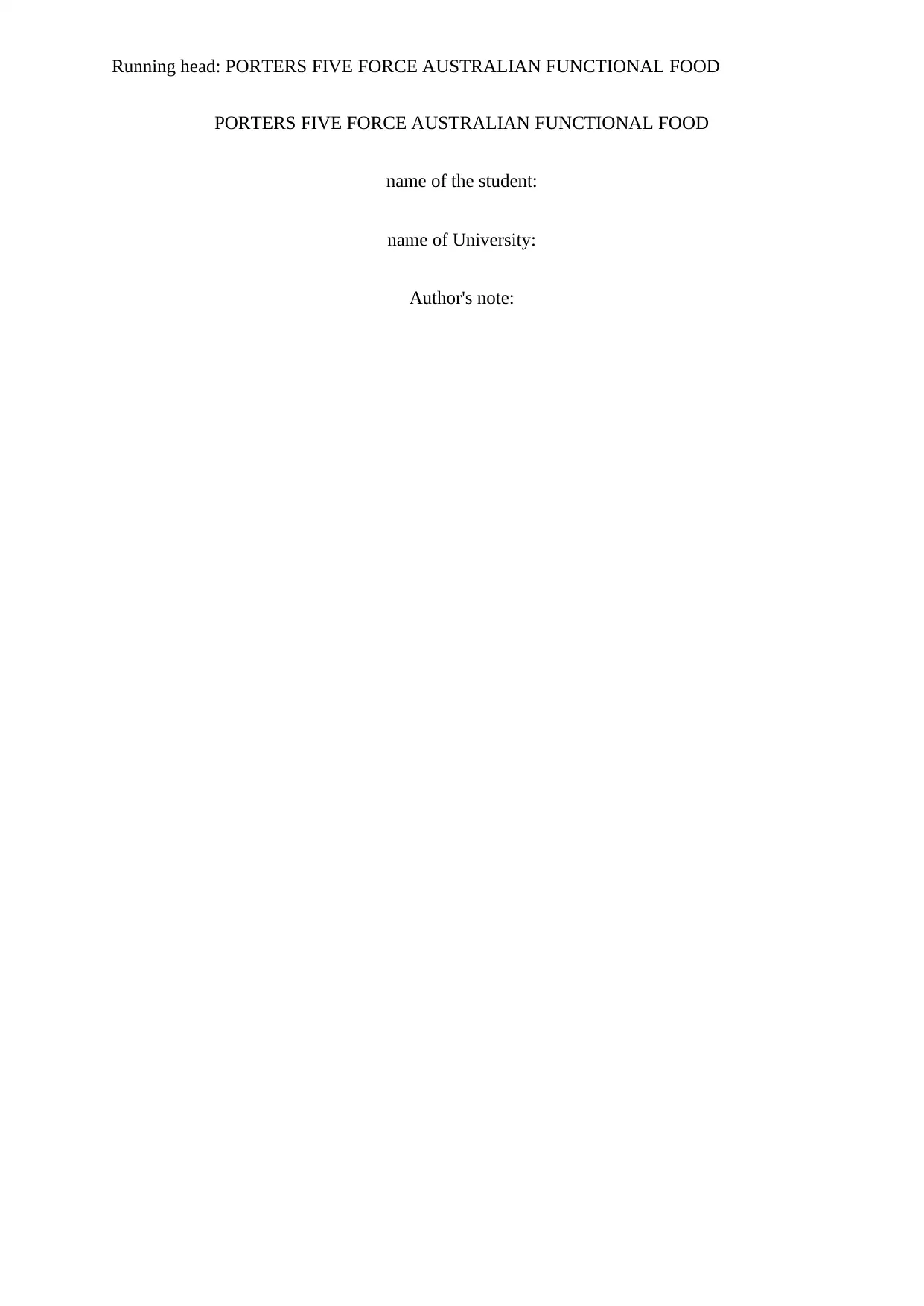
Running head: PORTERS FIVE FORCE AUSTRALIAN FUNCTIONAL FOOD
PORTERS FIVE FORCE AUSTRALIAN FUNCTIONAL FOOD
name of the student:
name of University:
Author's note:
PORTERS FIVE FORCE AUSTRALIAN FUNCTIONAL FOOD
name of the student:
name of University:
Author's note:
Secure Best Marks with AI Grader
Need help grading? Try our AI Grader for instant feedback on your assignments.
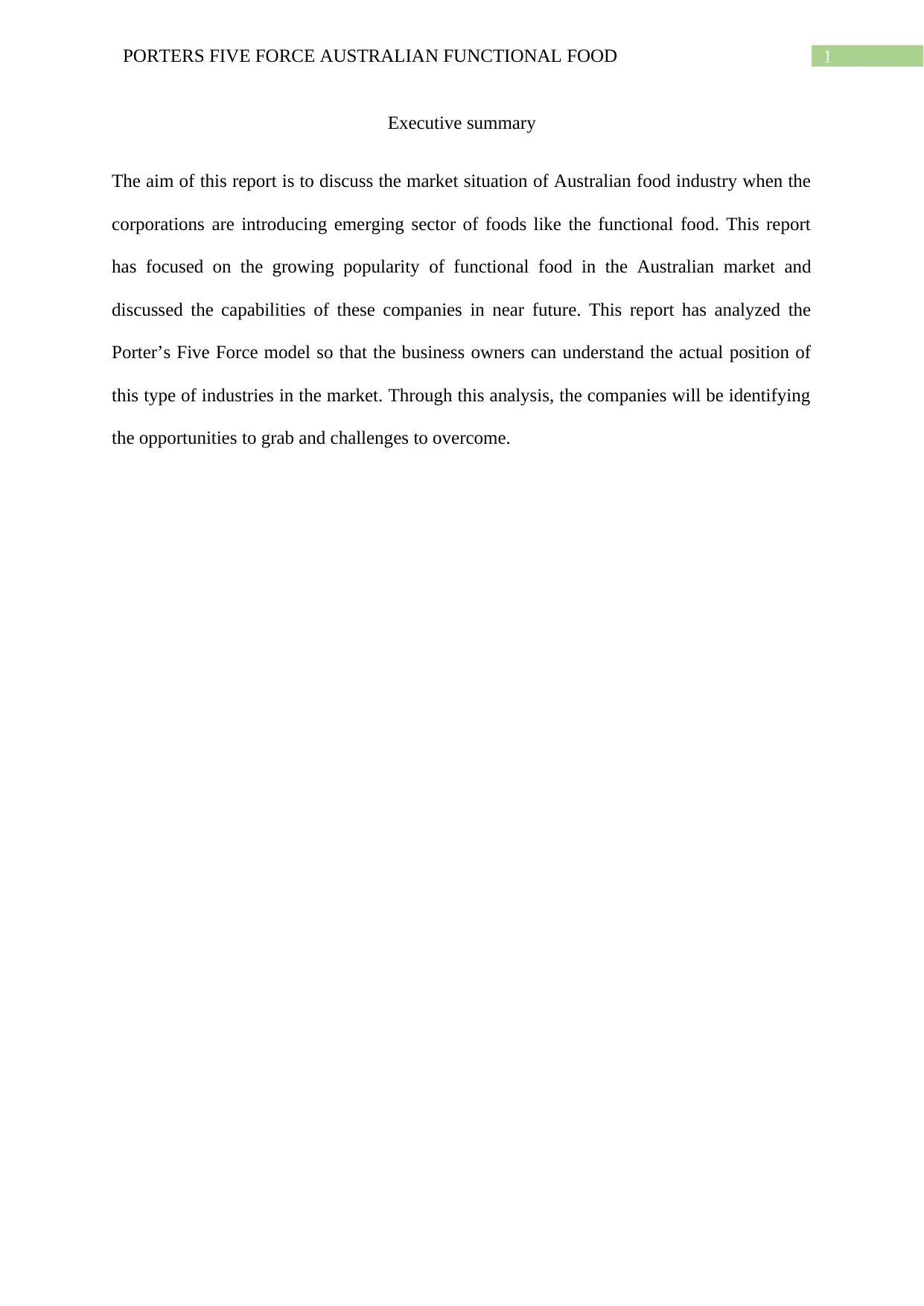
1PORTERS FIVE FORCE AUSTRALIAN FUNCTIONAL FOOD
Executive summary
The aim of this report is to discuss the market situation of Australian food industry when the
corporations are introducing emerging sector of foods like the functional food. This report
has focused on the growing popularity of functional food in the Australian market and
discussed the capabilities of these companies in near future. This report has analyzed the
Porter’s Five Force model so that the business owners can understand the actual position of
this type of industries in the market. Through this analysis, the companies will be identifying
the opportunities to grab and challenges to overcome.
Executive summary
The aim of this report is to discuss the market situation of Australian food industry when the
corporations are introducing emerging sector of foods like the functional food. This report
has focused on the growing popularity of functional food in the Australian market and
discussed the capabilities of these companies in near future. This report has analyzed the
Porter’s Five Force model so that the business owners can understand the actual position of
this type of industries in the market. Through this analysis, the companies will be identifying
the opportunities to grab and challenges to overcome.
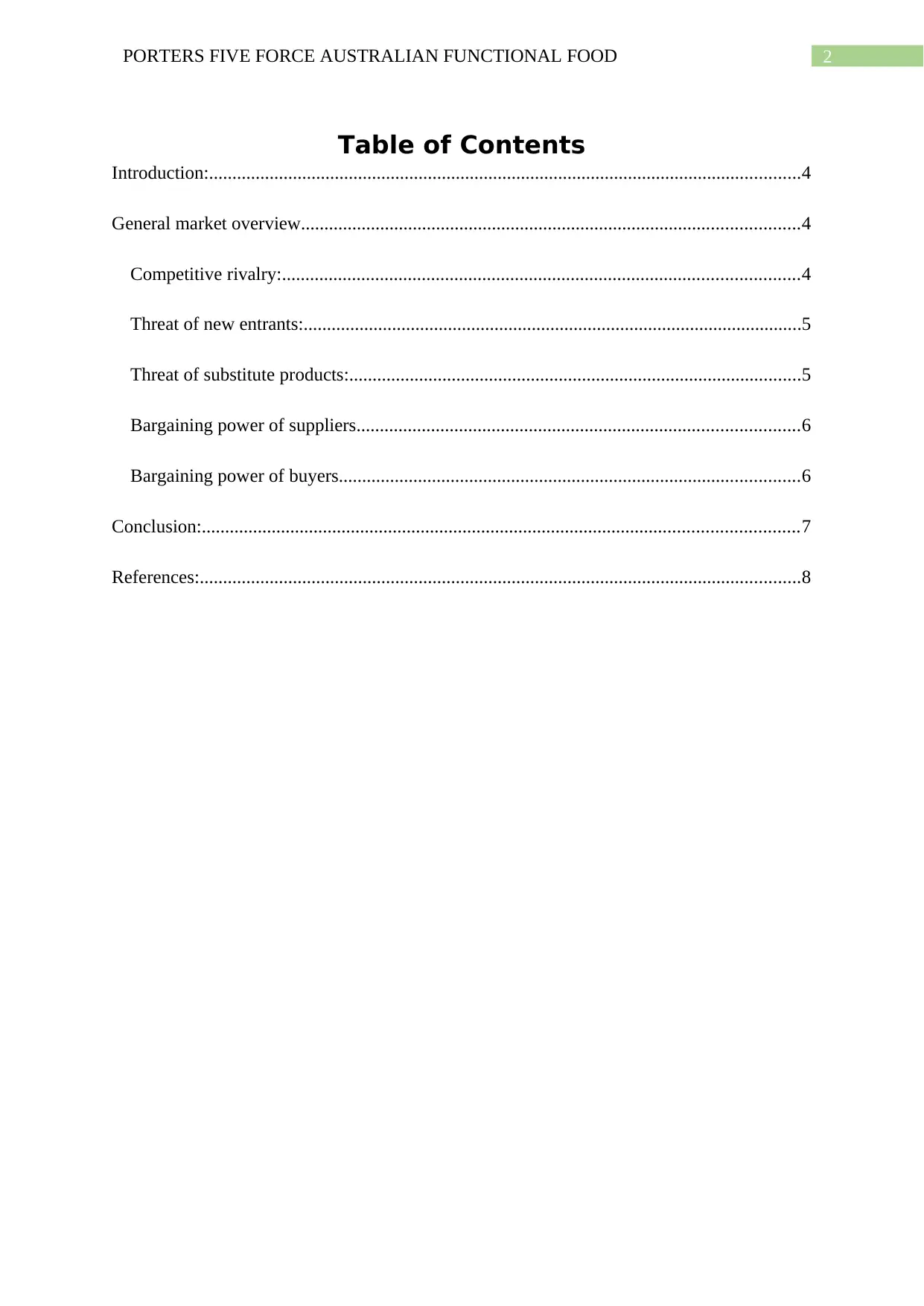
2PORTERS FIVE FORCE AUSTRALIAN FUNCTIONAL FOOD
Table of Contents
Introduction:...............................................................................................................................4
General market overview...........................................................................................................4
Competitive rivalry:...............................................................................................................4
Threat of new entrants:...........................................................................................................5
Threat of substitute products:.................................................................................................5
Bargaining power of suppliers...............................................................................................6
Bargaining power of buyers...................................................................................................6
Conclusion:................................................................................................................................7
References:.................................................................................................................................8
Table of Contents
Introduction:...............................................................................................................................4
General market overview...........................................................................................................4
Competitive rivalry:...............................................................................................................4
Threat of new entrants:...........................................................................................................5
Threat of substitute products:.................................................................................................5
Bargaining power of suppliers...............................................................................................6
Bargaining power of buyers...................................................................................................6
Conclusion:................................................................................................................................7
References:.................................................................................................................................8
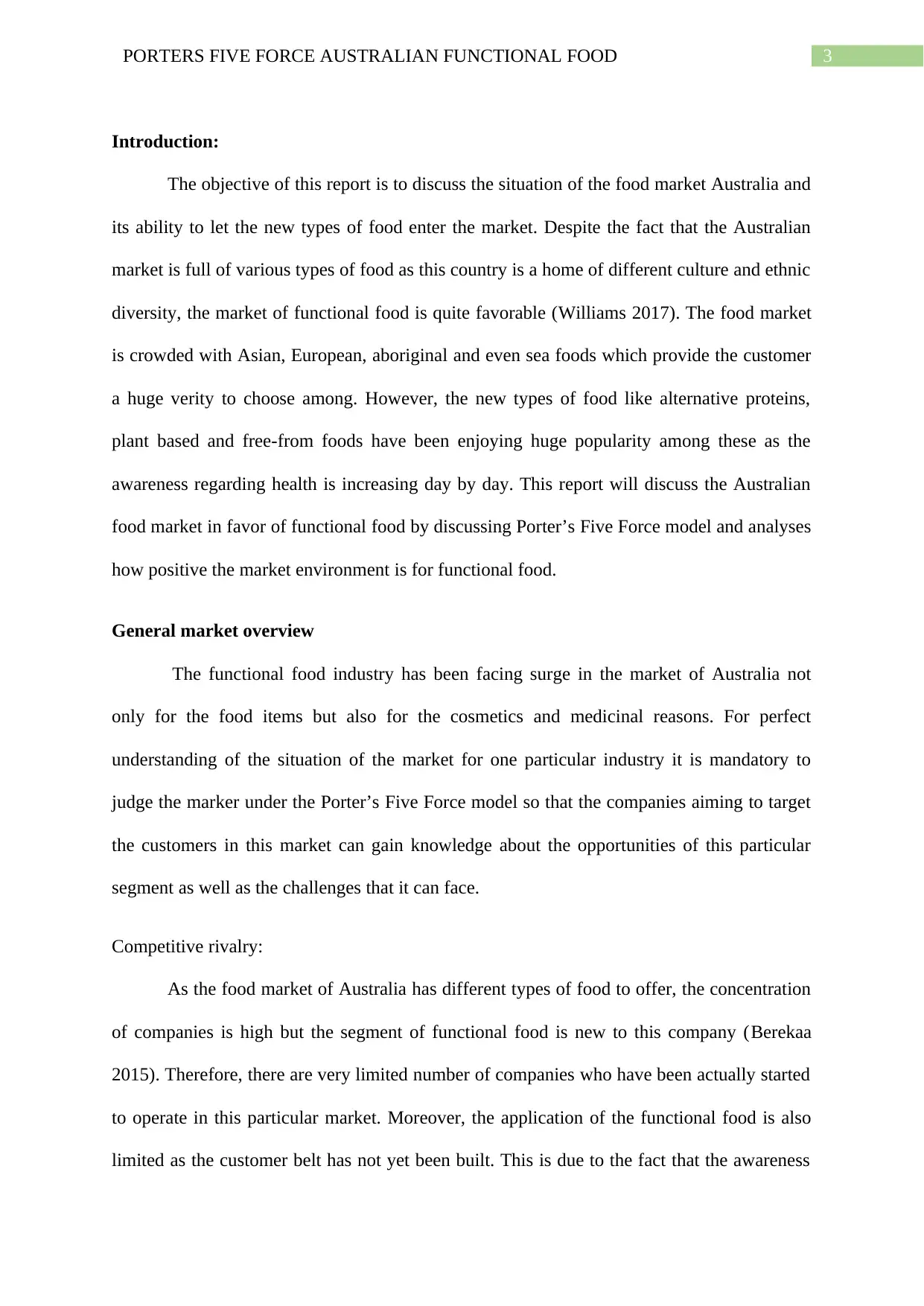
3PORTERS FIVE FORCE AUSTRALIAN FUNCTIONAL FOOD
Introduction:
The objective of this report is to discuss the situation of the food market Australia and
its ability to let the new types of food enter the market. Despite the fact that the Australian
market is full of various types of food as this country is a home of different culture and ethnic
diversity, the market of functional food is quite favorable (Williams 2017). The food market
is crowded with Asian, European, aboriginal and even sea foods which provide the customer
a huge verity to choose among. However, the new types of food like alternative proteins,
plant based and free-from foods have been enjoying huge popularity among these as the
awareness regarding health is increasing day by day. This report will discuss the Australian
food market in favor of functional food by discussing Porter’s Five Force model and analyses
how positive the market environment is for functional food.
General market overview
The functional food industry has been facing surge in the market of Australia not
only for the food items but also for the cosmetics and medicinal reasons. For perfect
understanding of the situation of the market for one particular industry it is mandatory to
judge the marker under the Porter’s Five Force model so that the companies aiming to target
the customers in this market can gain knowledge about the opportunities of this particular
segment as well as the challenges that it can face.
Competitive rivalry:
As the food market of Australia has different types of food to offer, the concentration
of companies is high but the segment of functional food is new to this company (Berekaa
2015). Therefore, there are very limited number of companies who have been actually started
to operate in this particular market. Moreover, the application of the functional food is also
limited as the customer belt has not yet been built. This is due to the fact that the awareness
Introduction:
The objective of this report is to discuss the situation of the food market Australia and
its ability to let the new types of food enter the market. Despite the fact that the Australian
market is full of various types of food as this country is a home of different culture and ethnic
diversity, the market of functional food is quite favorable (Williams 2017). The food market
is crowded with Asian, European, aboriginal and even sea foods which provide the customer
a huge verity to choose among. However, the new types of food like alternative proteins,
plant based and free-from foods have been enjoying huge popularity among these as the
awareness regarding health is increasing day by day. This report will discuss the Australian
food market in favor of functional food by discussing Porter’s Five Force model and analyses
how positive the market environment is for functional food.
General market overview
The functional food industry has been facing surge in the market of Australia not
only for the food items but also for the cosmetics and medicinal reasons. For perfect
understanding of the situation of the market for one particular industry it is mandatory to
judge the marker under the Porter’s Five Force model so that the companies aiming to target
the customers in this market can gain knowledge about the opportunities of this particular
segment as well as the challenges that it can face.
Competitive rivalry:
As the food market of Australia has different types of food to offer, the concentration
of companies is high but the segment of functional food is new to this company (Berekaa
2015). Therefore, there are very limited number of companies who have been actually started
to operate in this particular market. Moreover, the application of the functional food is also
limited as the customer belt has not yet been built. This is due to the fact that the awareness
Secure Best Marks with AI Grader
Need help grading? Try our AI Grader for instant feedback on your assignments.
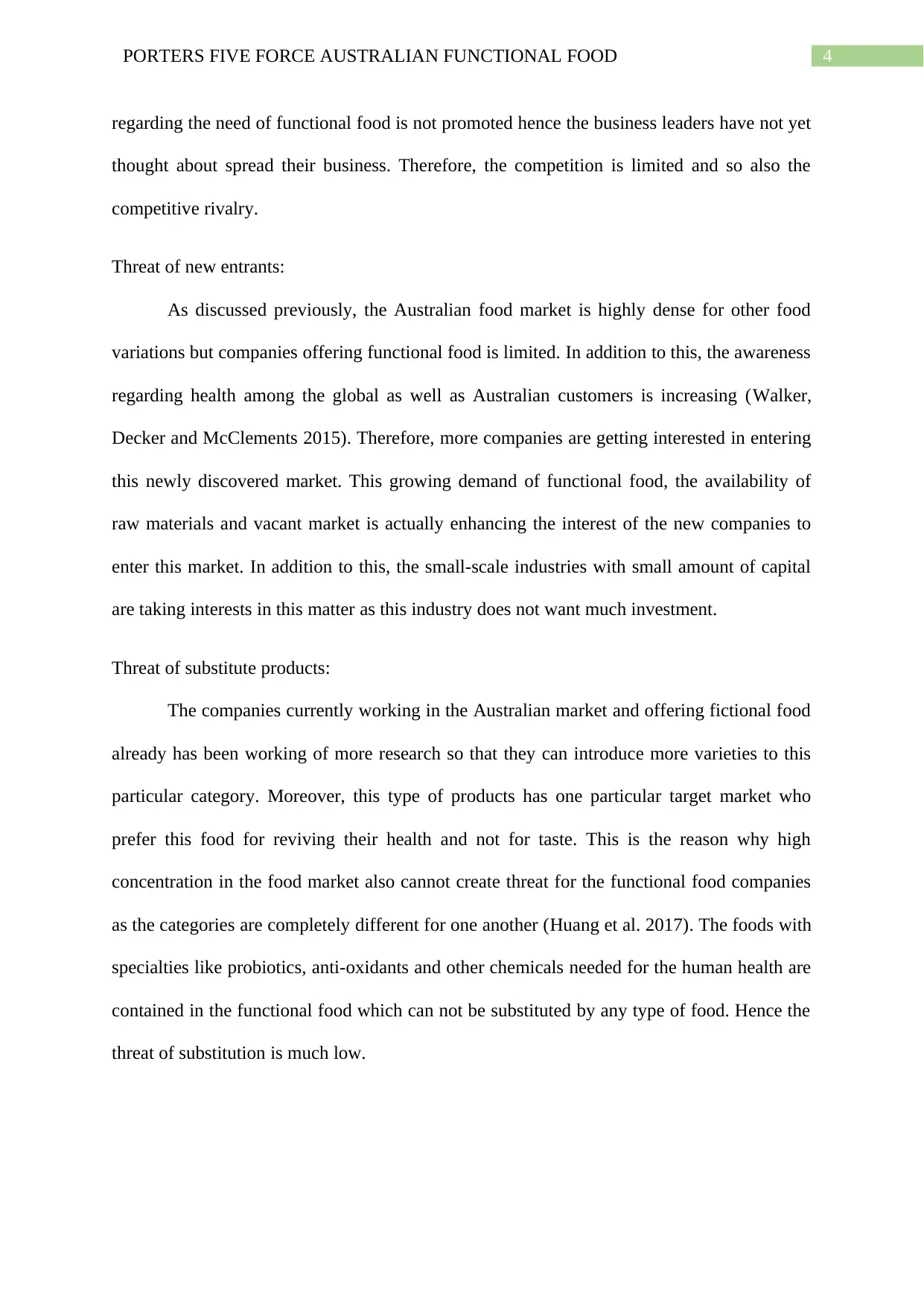
4PORTERS FIVE FORCE AUSTRALIAN FUNCTIONAL FOOD
regarding the need of functional food is not promoted hence the business leaders have not yet
thought about spread their business. Therefore, the competition is limited and so also the
competitive rivalry.
Threat of new entrants:
As discussed previously, the Australian food market is highly dense for other food
variations but companies offering functional food is limited. In addition to this, the awareness
regarding health among the global as well as Australian customers is increasing (Walker,
Decker and McClements 2015). Therefore, more companies are getting interested in entering
this newly discovered market. This growing demand of functional food, the availability of
raw materials and vacant market is actually enhancing the interest of the new companies to
enter this market. In addition to this, the small-scale industries with small amount of capital
are taking interests in this matter as this industry does not want much investment.
Threat of substitute products:
The companies currently working in the Australian market and offering fictional food
already has been working of more research so that they can introduce more varieties to this
particular category. Moreover, this type of products has one particular target market who
prefer this food for reviving their health and not for taste. This is the reason why high
concentration in the food market also cannot create threat for the functional food companies
as the categories are completely different for one another (Huang et al. 2017). The foods with
specialties like probiotics, anti-oxidants and other chemicals needed for the human health are
contained in the functional food which can not be substituted by any type of food. Hence the
threat of substitution is much low.
regarding the need of functional food is not promoted hence the business leaders have not yet
thought about spread their business. Therefore, the competition is limited and so also the
competitive rivalry.
Threat of new entrants:
As discussed previously, the Australian food market is highly dense for other food
variations but companies offering functional food is limited. In addition to this, the awareness
regarding health among the global as well as Australian customers is increasing (Walker,
Decker and McClements 2015). Therefore, more companies are getting interested in entering
this newly discovered market. This growing demand of functional food, the availability of
raw materials and vacant market is actually enhancing the interest of the new companies to
enter this market. In addition to this, the small-scale industries with small amount of capital
are taking interests in this matter as this industry does not want much investment.
Threat of substitute products:
The companies currently working in the Australian market and offering fictional food
already has been working of more research so that they can introduce more varieties to this
particular category. Moreover, this type of products has one particular target market who
prefer this food for reviving their health and not for taste. This is the reason why high
concentration in the food market also cannot create threat for the functional food companies
as the categories are completely different for one another (Huang et al. 2017). The foods with
specialties like probiotics, anti-oxidants and other chemicals needed for the human health are
contained in the functional food which can not be substituted by any type of food. Hence the
threat of substitution is much low.
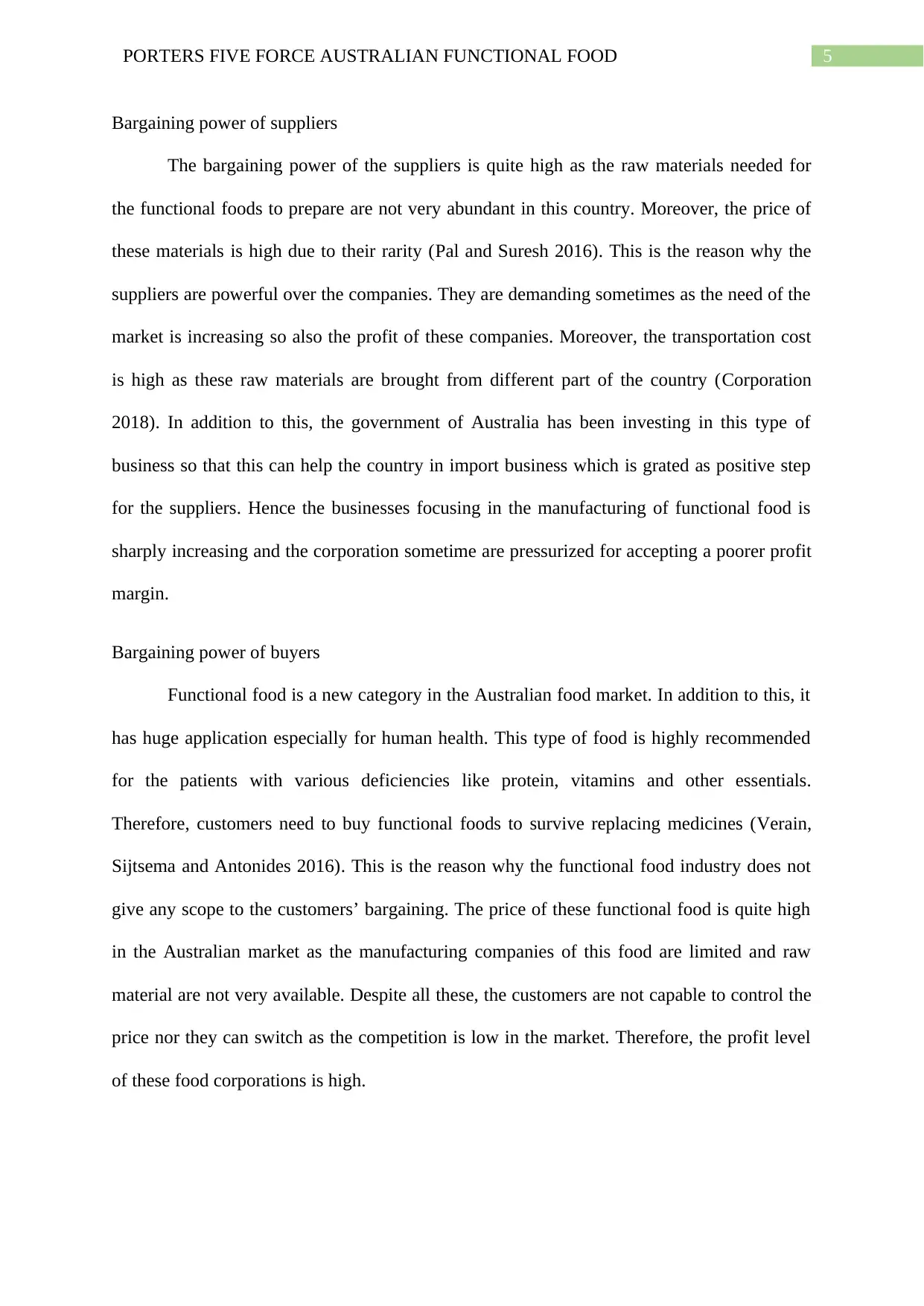
5PORTERS FIVE FORCE AUSTRALIAN FUNCTIONAL FOOD
Bargaining power of suppliers
The bargaining power of the suppliers is quite high as the raw materials needed for
the functional foods to prepare are not very abundant in this country. Moreover, the price of
these materials is high due to their rarity (Pal and Suresh 2016). This is the reason why the
suppliers are powerful over the companies. They are demanding sometimes as the need of the
market is increasing so also the profit of these companies. Moreover, the transportation cost
is high as these raw materials are brought from different part of the country (Corporation
2018). In addition to this, the government of Australia has been investing in this type of
business so that this can help the country in import business which is grated as positive step
for the suppliers. Hence the businesses focusing in the manufacturing of functional food is
sharply increasing and the corporation sometime are pressurized for accepting a poorer profit
margin.
Bargaining power of buyers
Functional food is a new category in the Australian food market. In addition to this, it
has huge application especially for human health. This type of food is highly recommended
for the patients with various deficiencies like protein, vitamins and other essentials.
Therefore, customers need to buy functional foods to survive replacing medicines (Verain,
Sijtsema and Antonides 2016). This is the reason why the functional food industry does not
give any scope to the customers’ bargaining. The price of these functional food is quite high
in the Australian market as the manufacturing companies of this food are limited and raw
material are not very available. Despite all these, the customers are not capable to control the
price nor they can switch as the competition is low in the market. Therefore, the profit level
of these food corporations is high.
Bargaining power of suppliers
The bargaining power of the suppliers is quite high as the raw materials needed for
the functional foods to prepare are not very abundant in this country. Moreover, the price of
these materials is high due to their rarity (Pal and Suresh 2016). This is the reason why the
suppliers are powerful over the companies. They are demanding sometimes as the need of the
market is increasing so also the profit of these companies. Moreover, the transportation cost
is high as these raw materials are brought from different part of the country (Corporation
2018). In addition to this, the government of Australia has been investing in this type of
business so that this can help the country in import business which is grated as positive step
for the suppliers. Hence the businesses focusing in the manufacturing of functional food is
sharply increasing and the corporation sometime are pressurized for accepting a poorer profit
margin.
Bargaining power of buyers
Functional food is a new category in the Australian food market. In addition to this, it
has huge application especially for human health. This type of food is highly recommended
for the patients with various deficiencies like protein, vitamins and other essentials.
Therefore, customers need to buy functional foods to survive replacing medicines (Verain,
Sijtsema and Antonides 2016). This is the reason why the functional food industry does not
give any scope to the customers’ bargaining. The price of these functional food is quite high
in the Australian market as the manufacturing companies of this food are limited and raw
material are not very available. Despite all these, the customers are not capable to control the
price nor they can switch as the competition is low in the market. Therefore, the profit level
of these food corporations is high.
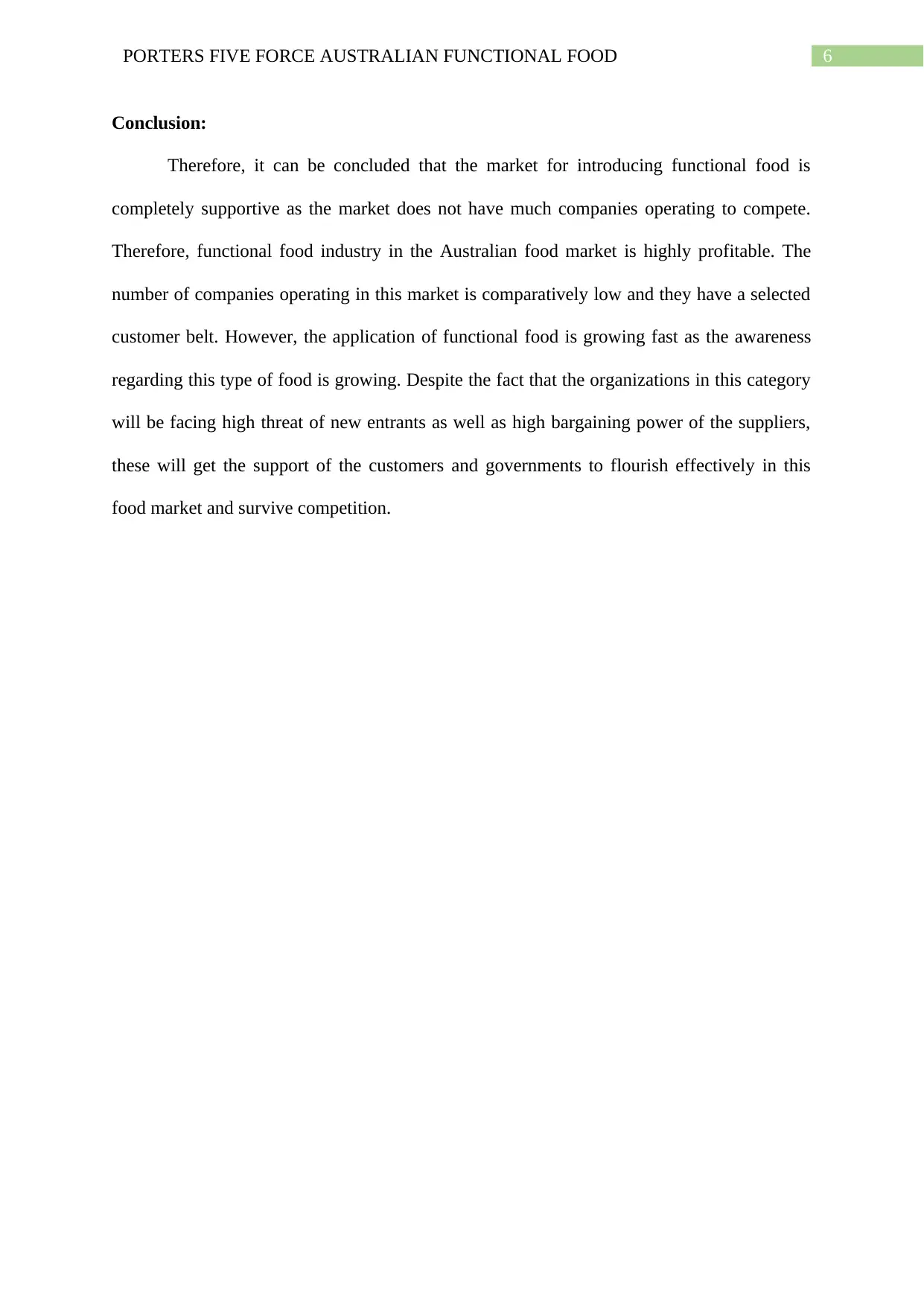
6PORTERS FIVE FORCE AUSTRALIAN FUNCTIONAL FOOD
Conclusion:
Therefore, it can be concluded that the market for introducing functional food is
completely supportive as the market does not have much companies operating to compete.
Therefore, functional food industry in the Australian food market is highly profitable. The
number of companies operating in this market is comparatively low and they have a selected
customer belt. However, the application of functional food is growing fast as the awareness
regarding this type of food is growing. Despite the fact that the organizations in this category
will be facing high threat of new entrants as well as high bargaining power of the suppliers,
these will get the support of the customers and governments to flourish effectively in this
food market and survive competition.
Conclusion:
Therefore, it can be concluded that the market for introducing functional food is
completely supportive as the market does not have much companies operating to compete.
Therefore, functional food industry in the Australian food market is highly profitable. The
number of companies operating in this market is comparatively low and they have a selected
customer belt. However, the application of functional food is growing fast as the awareness
regarding this type of food is growing. Despite the fact that the organizations in this category
will be facing high threat of new entrants as well as high bargaining power of the suppliers,
these will get the support of the customers and governments to flourish effectively in this
food market and survive competition.
Paraphrase This Document
Need a fresh take? Get an instant paraphrase of this document with our AI Paraphraser
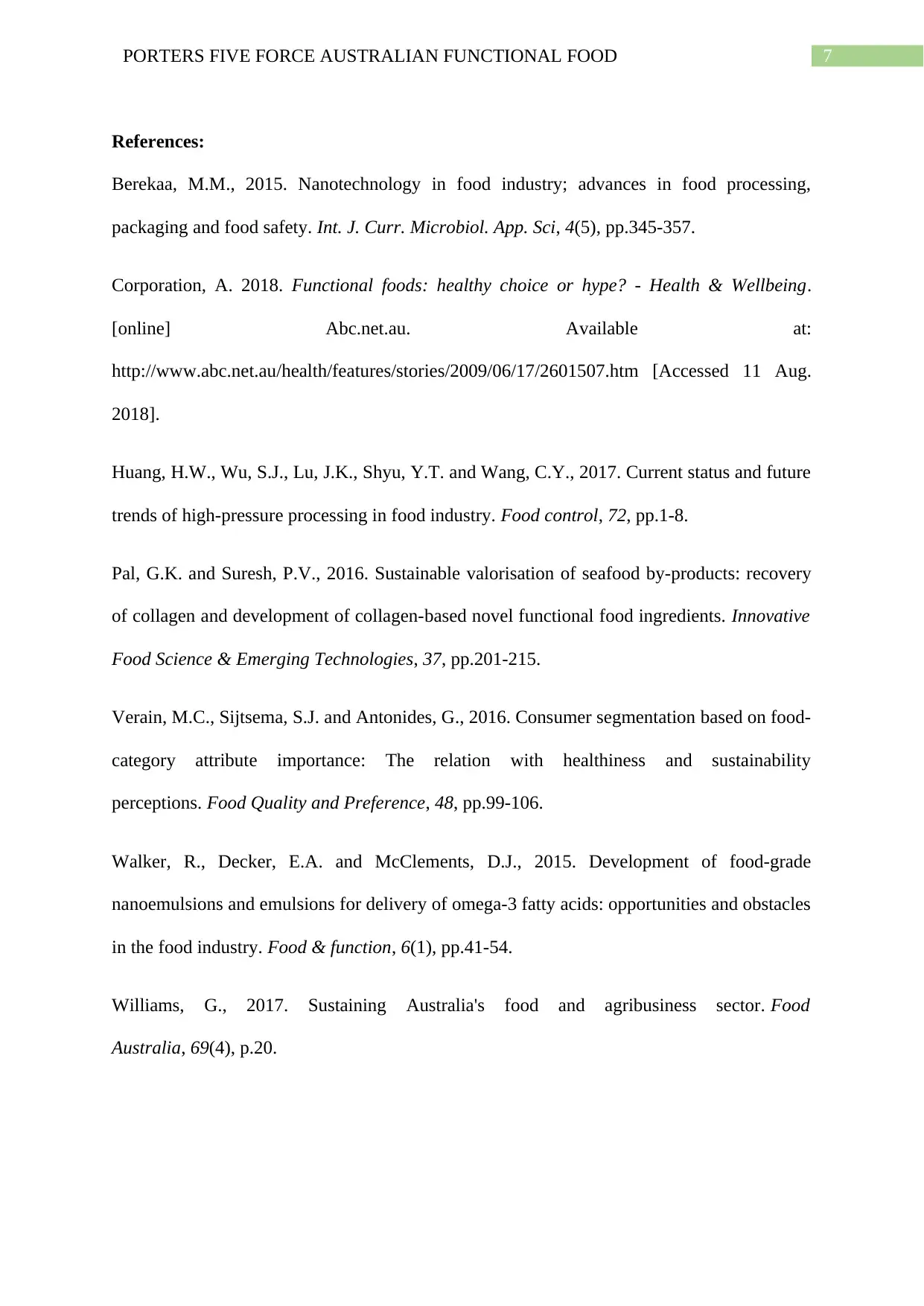
7PORTERS FIVE FORCE AUSTRALIAN FUNCTIONAL FOOD
References:
Berekaa, M.M., 2015. Nanotechnology in food industry; advances in food processing,
packaging and food safety. Int. J. Curr. Microbiol. App. Sci, 4(5), pp.345-357.
Corporation, A. 2018. Functional foods: healthy choice or hype? - Health & Wellbeing.
[online] Abc.net.au. Available at:
http://www.abc.net.au/health/features/stories/2009/06/17/2601507.htm [Accessed 11 Aug.
2018].
Huang, H.W., Wu, S.J., Lu, J.K., Shyu, Y.T. and Wang, C.Y., 2017. Current status and future
trends of high-pressure processing in food industry. Food control, 72, pp.1-8.
Pal, G.K. and Suresh, P.V., 2016. Sustainable valorisation of seafood by-products: recovery
of collagen and development of collagen-based novel functional food ingredients. Innovative
Food Science & Emerging Technologies, 37, pp.201-215.
Verain, M.C., Sijtsema, S.J. and Antonides, G., 2016. Consumer segmentation based on food-
category attribute importance: The relation with healthiness and sustainability
perceptions. Food Quality and Preference, 48, pp.99-106.
Walker, R., Decker, E.A. and McClements, D.J., 2015. Development of food-grade
nanoemulsions and emulsions for delivery of omega-3 fatty acids: opportunities and obstacles
in the food industry. Food & function, 6(1), pp.41-54.
Williams, G., 2017. Sustaining Australia's food and agribusiness sector. Food
Australia, 69(4), p.20.
References:
Berekaa, M.M., 2015. Nanotechnology in food industry; advances in food processing,
packaging and food safety. Int. J. Curr. Microbiol. App. Sci, 4(5), pp.345-357.
Corporation, A. 2018. Functional foods: healthy choice or hype? - Health & Wellbeing.
[online] Abc.net.au. Available at:
http://www.abc.net.au/health/features/stories/2009/06/17/2601507.htm [Accessed 11 Aug.
2018].
Huang, H.W., Wu, S.J., Lu, J.K., Shyu, Y.T. and Wang, C.Y., 2017. Current status and future
trends of high-pressure processing in food industry. Food control, 72, pp.1-8.
Pal, G.K. and Suresh, P.V., 2016. Sustainable valorisation of seafood by-products: recovery
of collagen and development of collagen-based novel functional food ingredients. Innovative
Food Science & Emerging Technologies, 37, pp.201-215.
Verain, M.C., Sijtsema, S.J. and Antonides, G., 2016. Consumer segmentation based on food-
category attribute importance: The relation with healthiness and sustainability
perceptions. Food Quality and Preference, 48, pp.99-106.
Walker, R., Decker, E.A. and McClements, D.J., 2015. Development of food-grade
nanoemulsions and emulsions for delivery of omega-3 fatty acids: opportunities and obstacles
in the food industry. Food & function, 6(1), pp.41-54.
Williams, G., 2017. Sustaining Australia's food and agribusiness sector. Food
Australia, 69(4), p.20.
1 out of 8
Related Documents
Your All-in-One AI-Powered Toolkit for Academic Success.
+13062052269
info@desklib.com
Available 24*7 on WhatsApp / Email
![[object Object]](/_next/static/media/star-bottom.7253800d.svg)
Unlock your academic potential
© 2024 | Zucol Services PVT LTD | All rights reserved.





